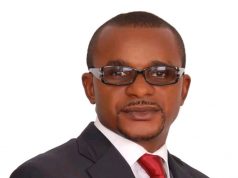
…As stakeholders canvass new strategy
The country may be on the verge of another waste of resources in the face of economic hardship and dwindling revenue as it begins another round of search for hydrocarbon in Sokoto basin.
For about 33 years, the Federal Government, through the Nigeria National Petroleum Corporation (NNPC) spent about $340 million and an additional N27 billion, in seismic expedition in the Lake Chad Basin without finding a drop of oil
But stakeholders in the oil and gas sector have warned the Muhammadu Buhari administration that unless it change its approach and strategy in the latest commitment for hydrocarbon search in the Sokoto basin, more resources would go down the drain without achieving the intended result.
NNPC had last week said it has started a process that would lead to the exploration of oil and gas in the Sokoto Inland Sedimentary Basin.
Its Group Managing Director, Dr. Maikanti Baru, stated this when he received the Governor of Sokoto State, Aminu Tambuwal, who paid a working visit to the NNPC Towers in Abuja.
Baru stated: “We have been on the issue of exploration in the frontier basin and so far, some measures of steps have been taken. We have already purchased aeromagnetic data and its being interpreted to determine the sedimentary thickness and the basin’s configuration.
“Secondly, we have awarded a contract for the geological mapping of the basin and I am happy to state here that samples have been collected, mapped, analysed and geological modelling executed so as to ensure data integration.”
He added that discussions were ongoing with Integrated Data Services Limited to award contract for surface geochemistry, ground gravity and magnetics.
This, according to him, is necessary to determine if hydrocarbon was generated in the basin and importantly, to integrate all data for understanding of the petroleum systems of the basin.
Baru said the NNPC would also carry out high resolution regional 2D seismic data acquisition to identify leads and prospects, after which a 3D seismic data acquisition would be carried out on them (leads and prospects).
“After all these are carried out, we will then begin to drill for oil and gas in the basin,” he added.
But the President of the Nigerian Association of Petroleum Explorationists (NAPE), Mr. Abiodun Adesanya, in his submission, said that if the country was not ready to fritter away scarce resources, the approach for oil search in Sokoto must be different from that of the Chad basin.
Adesanya said about 24 wells were drilled in the Chad basin without any prospect of oil while three were drilled in the Gombe basin, with gas discovered in the one drilled by Shell. The other two empty wells were drilled by Chevron and Total.
“It depends on the way they approach it. If they approach it the way we did since 1984 when the search for hydrocarbon commenced in the Lake Chad basin, then that is not the way to go. But if things are done in the industry standard procedure, then it could be the right thing to do.”
On what should be done to get the right result in the Sokoto basin, Adesanya said search for oil is in stages and sequence and must be followed to the letter. He explained that approach for oil search in frontier basins remained different from that of shallow and deep water terrain.
For frontier basin oil search, he said airborne aero magnetic survey must be conducted to know where sedimentary rocks are located, alongside seismic acquisition to see the image clearer and drill certain test wells, which would be followed by the analysis of the results and data to guide on the next decisions to make.
Adesanya’s views were equally echoed by the Publisher of Africa Oil and Gas Report, a magazine focusing on the petroleum sector, Mr. Toyin Akinosho, when he advised that the NNPC, in the case of the Sokoto basin, should deploy better and advanced technology far above what was used in the Chad basin for the country to record a different result.
He said the decision of NNPC to go in search of hyrdrocarbon in Sokoto remained a step in the right direction, especially in the face of International Oil Companies’ (IOCs’) reluctance to do so.
Akinosho, who is also a geologist with several years of experience working for Chevron Nigeria Limited, said despite the fact that there are proven reserves in the Niger Delta, IOCs were already divesting from the region, adding that the Benin basin that has proved to be rich in oil was also out of the investment areas of the IOCs.
‘‘When Yinka Folawiyo moved into the Benin basin, Chevron that was invited to be part of the exploration activities later pulled out. IOCs do not seem to be interested in regions with little reserves. They rather prefer to move into the deep water region of the Niger Delta,’’ he said.
He explained that the decision of the IOCs to avoid investments in exploration activities in the frontier may have compelled NNPC to take the lead, adding that the corporation was doing what it was expected to do as obtainable in other climes.
‘‘For me, I will support the vision of the NNPC to commence exploration activity in the Sokoto basin even if they don’t find anything there. The idea behind exploration is not just about finding oil but having a better understanding of the country’s geological mapping,’’ he said.
The Africa Oil and Gas publisher added that the search for hydrocarbon in the Sokoto basin is also another way of building the country’s human capacity in the area of geosciences, while agencies involved in the process would further understand better the geological mapping of the country.
Partner, Bloomfield Law Practice, Mr. Ayodele Oni, took a different approach, saying it may be slightly arbitrary to compare the Chad basin to the Sokoto basin in absolute terms, and it would be premature, and perhaps hasty, to bash NNPC’s drive at exploring deposits within the Sokoto basin only on the basis of the unsatisfactory result of the hydrocarbon search in Chad.
‘‘This, of course, is unless proven that the conditions on both sites clearly make them unsuitable for exploration and further development. Furthermore, even taking into account the difficulty in developing the Chad, implementation of new technology may make it easier to extract deposits inaccessible through conventional means,’’ he said.
Surprisingly, the new hydrocarbon search is coming at a time the world is thinking of switching to electric cars expected to provide the opportunity for a cleaner, greener mobility future that assigns dirty diesel cars and trains, which choke cities and commuters, to the scrapyard of obsolescence.
“It is no longer a question of whether this happens, but how quickly”, stated a recent report by Transport & Environment.
The report shows that by the end of this year, there will be more than half a million battery, electric and plug-in hybrid vehicles on Europe’s roads; and sales this year should account for 1.5 percent of the market.
This means a bad news for oil producing countries like Nigeria as the electric vehicle (EV) earthquake is finally shaking carmakers from their complacency.
For instance,Volkswagen launched its I.D. concept car, which is set for production in 2020 and will have an electric range of at least 400 kilometers. Herbert Diess, head of the VW brand, described the car as “revolutionary,” comparing its impact on the brand’s history to the Beetle or the Golf. This followed an earlier announcement that the VW Group aspires to get a quarter of its sales from electric by 2025 and is planning 20 models.
Mercedes launched an equivalent Generation EQ concept car that will become a new sub-brand with at least 10 plug-in models. Dieter Zetsche, its CEO, announced: “We’re now flipping the switch … ready for the launch of an electric product offensive that will cover all vehicle segments, from the compact to the luxury class.”
In other announcements, Opel unveiled the Ampera-e (a European clone of the Chevrolet Bolt); and Renault and BMW detailed upgrades of the Zoe and i3 respectively, with Renault commenting: “Our vision of the electric market is that it is not a niche market.”
So why are carmakers finally changing their attitude? Four recent developments have been particularly important in triggering action:
The rapid growth in EV sales in China, which is now the world’s biggest market and dominated by national manufacturers. Non-Chinese carmakers are desperate to succeed in this expanding market and terrified their Chinese competitors, like BYD, will soon be successfully exporting to Europe;
The astonishing fall in the price of battery packs to around $150 per kilowatt hour, a level which makes EVs competitive with conventional vehicles. Also, it is possible to produce affordable EVs with ranges of over the psychologically important 300 kilometer range;
The success of the Paris climate talks is driving a progressive tightening of car CO2 emissions limits around the world, inevitably leading to a gradual phase out of fossil fuels. This has been hastened by the dieselgate scandal and the realization that the rest of the world will not be tricked into using diesel as a way to artificially reduce CO2 emissions as Europe did;
The remarkable pre-sales of the new Tesla Model 3 — a car for which 400,000 drivers put down $1,000 each without even sitting in it. Suddenly even German premium carmakers recognized that a true market exists that they needed to supply it.




